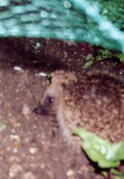On p. 139 of my book about Paganism I wrote:
“Ordinary human living threatens ordinary other-than-human living. Sometimes it does this intentionally, e.g. fox hunting, meat production, whaling, pest-control, leather production, badger baiting, vivisection. Equally often it does so unintentionally and just by the way. Our cars frequently run over hedgehogs, for example. I do not intend to give “meaning” to this unnecessary slaughter but it can help us to understand the relationship between ecological thinking, animist Paganism and neighbourly living. Other Pagans express their ecological vision equally powerfully by hunting animals for food.
If drivers stop their cars to move a hedgehog from the middle of a road, this is not because the hedgehog was praying for salvation. Nor would the rescued hedgehog go on to develop a religion praising and thanking that human or all humankind. It would simply carry on with its ordinary life. This is much the same approach as an animist Pagan might take to those other-than-human people which, tradition teaches, are more powerful than humans, i.e. deities and the Faerie. It might be encouraging to know that such beings share a Pagan’s delight in certain places and times. Their presence at festive occasions is sometimes invited but is not necessary or central to the celebration of that festival. Usually humans get on with their lives, hedgehogs get on with theirs, deities with theirs. Sometimes paths cross and this can be dangerous. This is not necessarily because humanity is thought ill of, though that might be understandable, and only sometimes because, so tradition teaches, the Faerie do things which are harmful. What “They” consider to be entertaining is, for humans, as dangerous as our relaxing drive in the country is dangerous to hedgehogs. Awareness of these dangers can enable people to adjust our lives to be less dangerous. They can become more ecological by enhancing the diversity of life. However, it will never be possible to live without taking life, doing violence to those with whom this planet home is shared.”
(In the new edition this is on p.135).
(Also, this re-presents an idea I first explored in an article called “Gods and Hedgehogs in the Greenwood”, in Gavin Flood (ed.) Mapping Invisible Worlds, Edinburgh University Press, 1993).
This extended metaphor for human interactions with other-than-human persons was originally meant to suggest that animist Pagans might engage with deities, the faery folk and others, somewhat in the same ways as they engage with hedgehogs. And that some such encounters might be as dangerous for humans as hedgehog encounters with ordinary human life might be dangerous for them.
Of course, the metaphor has now taken on a life of its own and the spiky flea ridden beasts are never far away. (Hurrah!) So, in my discussions about animism I honour them as representatives of the wider community of other-than-human persons.
| hedgehog that visited our vegetable garden one solstice eve |
 |
Doug Ezzy extends the discussion in his contribution to Pagan Visions for a Sustainable Future (co-edited by Ly de Angeles, Emma Restall Orr and Thom van Durren; Llewellyn, 2005: 161-72). Of course, he does so with reference and respect to wombats, so his article is called “I am the Mountain Walking: Wombats in the Greenwood”.
In going beyond the original point (that the ordinary life or lifestyle of one species is likely to endanger the lives of other persons), these hedgehogs and wombats also refuse to be tamed and pacified as “power animals” or “helpers”. They remain toothy, spiky, clawed, flea-ridden and often self-interested beasts. “Which is nice.”
And so, because hedgehogs are our Others, never the Same, they also enable us to think about ethics. A good beginning in this direction has been made in brilliant articles by Doug Ezzy (“Geographical Ontology: Levinas, Sacred Landscapes and Cities”, The Pomegranate 61 [2004]: 19-33) and Barb Davy (“Being at Home in Nature: A Levinasian Approach to Pagan Environmental Ethics”, The Pomegranate 7.2 [2005]: 157-72).
| hedgehog wall plaque in Budapest |
And finally, for now, thanks to Andy Letcher for pointing me to Hugh Warwick's photo gallery — a fine blend of celebration, protest, information and reporting — which not only includes photos of the Newbury bypass action reunion, 7 Jan 2006, the subject of our discussion, but also includes an album on hedgehogs.
Do I need to say anything about turtles? No, you all know what they're about, don't you ...
and then there are the badgers - now (February 2008) waking up and getting killed on our roads

